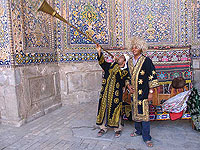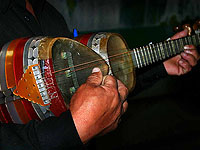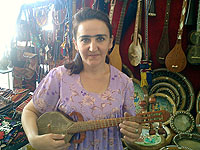 |
|
Uzbekistan - Music |
||||
|
The monuments of material culture (cave pictures, monumental sculpture, bas-reliefs, statuettes, and other) and the writings, which have survived up to these days, (from 2nd century AD), testify to the ancient sources of the musical legacy of the Uzbek people. The best samples of musical art have received generalized illumination in the treatises of Central Asian scientists about music (Faraby, Ibn Sina, Khorezmy, Jomy and others). Hereinafter the musical culture of the Uzbek people developed, keeping its originality. Uzbek national and oral-professional music has 4 basic local styles -Khorezm, Ferghana-Tashkent, Bukhara-Samarkand, and Surkhandarya -Kashkadarya, which came as the result of ethnic allocation. Medieval city in the region had a tradition of settling in quarters according to one's occupation. This was common for musicians as well, they lived in the "street of singers", "street of composers" etc. Uzbek songs can be divided into songs of certain times and certain circumstances (ritual - "Yor-Yor", "Kelin salom", calendar - "Navruz", labor - "Mayda", "Yozi", and others), and those executed at any time. Koshuk is a household song structured with a melody of a small range, covering one or two stanza of the poetic text. Lapar mdyaila a re executed in support of comic dances, games. Ashula is a lyrical song with a developed melody of a wide range and syncope rhythm. The basis of Uzbek national music is diatonic, but there are elements of chromatics as well. Variability and modulation are widely applied in basic national songs. The rhythm of national songs is quite various. National-professional musicians studied under supervision of famous artists. Notation was not commonly used and singers did not practice it at all. The basic classical fund of professional music of oral tradition is rnagom, consisting of several cycles according to local attributes. Musical tools are also rich of variety: string-bowed -ghijjak, kobuz, sat(setar), string-plucked - dombra, dutar, tanbur, ud, rubab, string- shock - chang string-wind - sibizg bulaman, surnai, kashnai, wind- flute - nai, gajir nai, bit-wind - karnai, shock-membrane - doira, noghora, chindaul, and others. Solo and group singers are equally developed. Main characteristics of Uzbek ensembles are their play in unison. Traditional Uzbek orchestra of national tools (play in 2-3 characteristics) consists of several kinds of tools, which gives a rich sounding scale. Traditional and intensive development of Uzbek musical art began mainly in the 20th century. Basic creative problems are practically solved, and genre - Uzbek musical drama and musical comedy, concentrating on traditions of scenic and musical art was generated. Development of musical dramas promoted conception of Uzbek operas and other scenic genres. In 1918 national conservatory was launched in Uzbekistan with its branches opened in Samarkand , Ferghana and Bukhara later on. Jointly with famous connoisseurs dramatists, G. Zafary, Sh. Khurshid commenced first Uzbek music scenic products "Khalima" (1920), "layii and Majnun" and "Farkhod and Shirin" (1922) based on national melodies. In 1924 M. Koriyokubov launched ethnographic concert ensemble in Tashkent. In 1934 the High School of Music was opened in Tashkent (since 1936 it became the Tashkent State Conservatory). Tashkent has become a musical center. In 1936 the Uzbek state philharmonic was established, where ensembles, choir chapels, symphonic orchestra, and orchestra of Uzbek national instruments were formed. On the basis of a national melody symphonic scores were created (M. M. Ippolitov-Ivanov, S. N. Vasilenko, V. A. Zolotaryov; later N. P. Rakov, R. M. Glier, and M. Burkhonov, M. Leviev, M. AshraJfy). |


